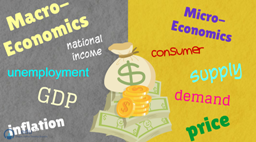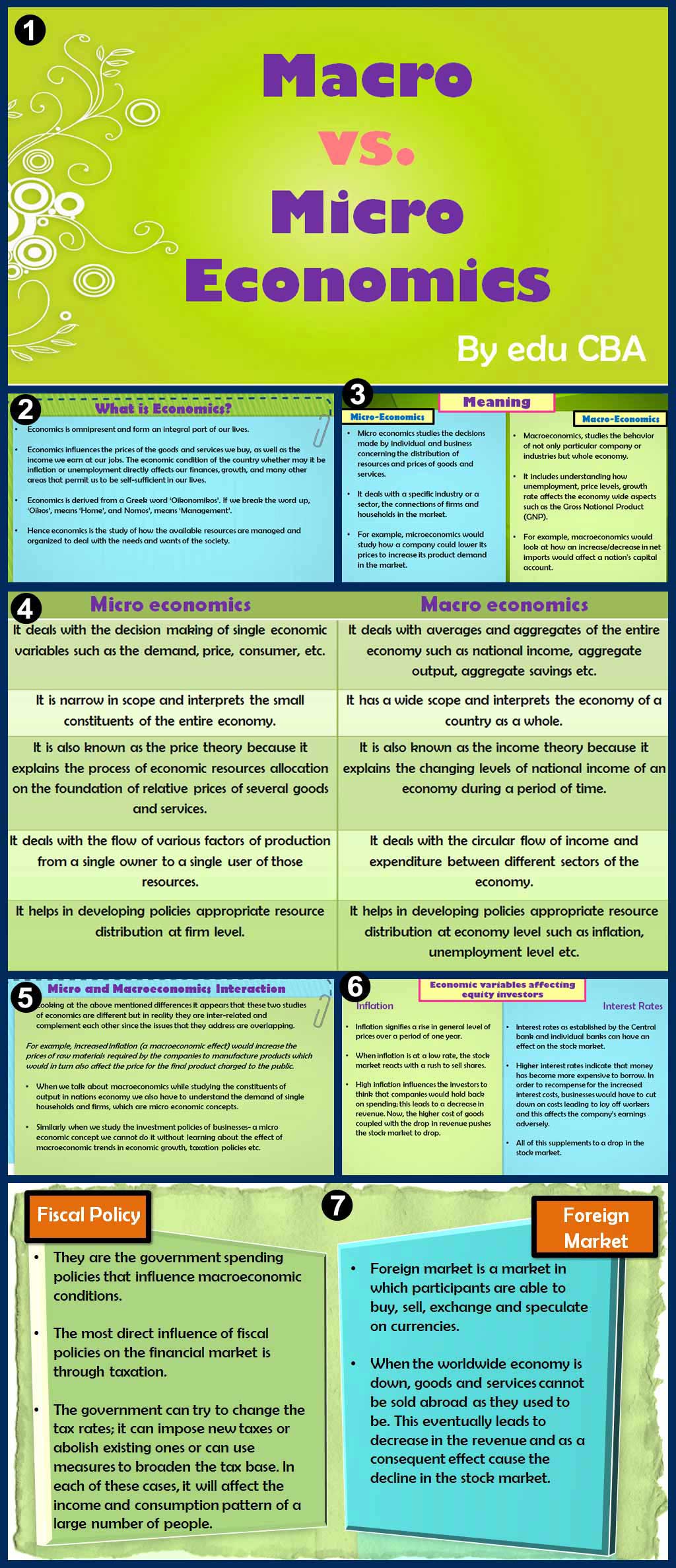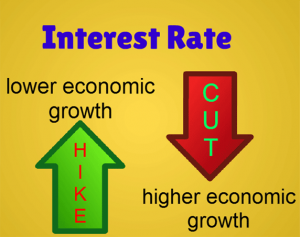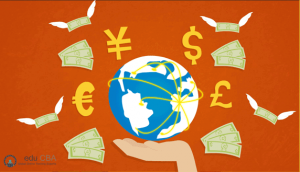Updated October 11, 2023

What is Macroeconomics vs Microeconomics?
Economics is omnipresent and forms an integral part of our lives. Economics influences the prices of the goods and services we buy and the income we earn at our jobs. The country’s economic condition, whether inflation or unemployment, directly affects our finances, growth, and many other areas that permit us to be self-sufficient. We all use and have money. Suppose you have 200 dollars; paying off your bill or spending it on an outing is all an economic decision. This article on Macroeconomics vs Microeconomics attempts to analyze and understand these issues and their effects on investors.
Before we see the two most important branches of economics, viz. microeconomics and macroeconomics, and their relationship, let’s first understand this attractive term economics. Economics is derived from the Greek word ‘Oikonomikos.‘ If we break the word up, ‘Oikos’ means ‘Home,’ and Nomos’ means ‘Management.’ The entire society as a family has unlimited wants, which are ever-increasing, and the sources available to satisfy them are limited. Hence, economics is the study of how the available resources are managed and organized to deal with the needs and wants of society.
Recommended Courses
The article on Macroeconomics vs Microeconomics is structured as below –
- Macroeconomics vs Microeconomics Infographics
- Understanding Macroeconomics vs Microeconomics
- Does Macroeconomics vs Microeconomics interact with each other?
- How do macroeconomic vs microeconomic variables affect equity investors?
Macroeconomics vs Microeconomics Infographics
Learn the juice of this article in just a single minute, Macroeconomics vs Microeconomics.

Understanding Macroeconomics vs Microeconomics
As the name suggests, Microeconomics studies the decisions made by individuals and businesses concerning the distribution of resources and prices of goods and services. It deals with a specific industry or a sector, the connections of firms and households in the market. At the same time, saying so, we also consider the taxes and other regulations that governments have created. It primarily focuses on the supply, demand, and other forces that define the price levels of goods and services in the economy.
Microeconomics would study how a company could lower its prices to increase its product demand in the market.
On the other hand, macroeconomics studies the behavior of not only particular companies or industries but the whole economy. It includes understanding how unemployment, price levels, and growth rates affect economy-wide aspects such as the Gross National Product (GNP).
Macroeconomics would look at how an increase/decrease in net imports would affect a nation’s capital account.
Looking at the two differences between macroeconomics and microeconomics, we could say that studying an individual paper mill manufacturing paper would be microeconomics. Still, if we look at the whole paper manufacturing sector, it would be macroeconomics.
The following table will briefly distinguish macroeconomics vs microeconomics examples;
| Microeconomics | Macroeconomics |
|---|---|
| It deals with the decision-making of single economic variables such as demand, price, consumer, etc. | It deals with averages and aggregates of the entire economy, such as national income, aggregate output, aggregate savings, etc. |
| Microeconomics is narrow in scope and interprets the minor constituents of the entire economy. | It has a broad scope and interprets a country’s economy. |
| It is also known as the price theory because it explains the process of economic resource allocation on the foundation of relative prices of several goods and services. | Macroeconomics is also known as the income theory because it explains an economy’s changing national income levels during a period. |
| It deals with the flow of various factors of production from a single owner to a single user of those resources. | It deals with the circular flow of income and expenditure between different sectors of the economy. |
| Microeconomics helps in developing policies appropriate for resource distribution at the firm level. | It helps develop policies appropriate for resource distribution at the economic level, such as inflation, unemployment level, etc. |
Does Macroeconomics vs Microeconomics interact with Each Other?
Looking at the differences mentioned above between macroeconomics vs microeconomics, it appears that these two economics studies are different, but in reality, they are interrelated and complement each other since the issues they address overlap.
Increased inflation (a macroeconomic effect) would increase the prices of raw materials required by the companies to manufacture products, which would, in turn, also affect the price of the final product charged to the public.
Microeconomics and Macroeconomics are both exploring the same things but from different viewpoints. When we talk about macroeconomics while studying the constituents of output in a nation’s economy, we also have to understand the demand of single households and firms, which are microeconomic concepts. Similarly, when we study the investment policies of businesses- a microeconomic idea we cannot do it without learning about the effect of macroeconomic trends on economic growth, taxation policies, etc.
How do Macroeconomic vs Microeconomic Variables Affect Equity Investors?
Various economic and social factors can affect the stock market. Every finance professional or investor must be aware of these factors before deciding to invest in them.
If there is increasing inflation in the economy it would have consequent effects on the stock market.
-
Inflation and Deflation

Inflation signifies a rise in the general level of prices over one year. It can have contrary effects on the stock market. When inflation is low, the stock market reacts with a rush to sell shares. High inflation influences investors to think that companies would hold back on spending; this leads to a decrease in revenue. The higher cost of goods and the drop in revenue push the stock market to drop.
There have been cases where goods and services prices have continuously decreased, but such instances are exceptional. This occurrence is called deflation. While deflation would sound like it should be received well by investors, it is a reason for a drop in the stock market since they perceive deflation as the consequence of a weak economy.
This inflation can have a significant impact on other macroeconomic variables; let’s understand where and how;
- Exchange Rate: Persistent prevalence of higher inflation in a country (say Country P) compared to the inflation in another country (say Country Q) generally leads to currency depreciation in Country P.
- Interest Rates: When the price level rises, each currency unit can buy fewer goods and services than before, reducing the currency’s purchasing power. So, people with excess funds demand higher interest rates as they want to protect the returns of their investments against the adverse impact of higher inflation. As an outcome, with rising inflation, interest rates tend to increase. The reverse happens when inflation declines.
- Unemployment: There is an opposite relationship between the rate of unemployment and the rate of inflation in an economy. It has been perceived that there is a stable short-run trade-off between unemployment and inflation.
-
Interest Rates

From the lender’s perspective, interest can be considered an “opportunity cost‘ or “rent of money,” and interest rate is the rate at which interest accumulates over time for the amount given as a loan. From a borrower’s perspective, the interest rate is the cost of capital, i.e., the cost that a borrower has to sustain to access funds.
Interest rates, as established by the Central bank and individual banks, can affect the stock market. Higher interest rates indicate that money has become more expensive to borrow. To repay for the increased interest costs, businesses would have to cut down on costs, leading to laying off workers. Also, the company cannot borrow as much as it used to, adversely affecting its earnings. All of this supplements a drop in the stock market.
-
Fiscal Policy

They are the government spending policies that influence macroeconomic conditions. Through fiscal policy, regulators try to improve unemployment rates, control inflation, stabilize business cycles, and influence interest rates to control the economy.
The most direct influence of fiscal policies on the financial market is taxation. The government can try to change the tax rates; it can impose new taxes, abolish existing ones, or use measures to broaden the tax base. Each of these cases will affect many people’s income and consumption patterns. Depending upon the tax measure, it will positively or negatively impact the financial market. For example, suppose the personal income tax rate is lowered. In that case, it is likely to see an upturn in people’s disposable income and can positively impact the financial markets through enhanced financial savings. On the other hand, introducing a long-term capital gains tax may hurt the market.
-
Foreign Market

Participants can buy, sell, exchange, and speculate on currencies in a foreign market.
When the worldwide economy is down, goods and services cannot be sold abroad as they used to be. This eventually leads to a decrease in revenue and, consequently, causes the stock market to decline. If foreign stock exchanges start weakening or experience sharp declines, a ripple effect can be anticipated. This eventually results in an overall drop in the global stock market.
After understanding all this, we could comprehend that both Macroeconomics and Microeconomics provide essential tools for any finance professional and should be studied together to completely understand how corporations function and make revenues and, thus, how a whole economy is managed and continual.
Recommended Articles
Here are some articles that will help you to get more detail about Macroeconomics vs Microeconomics, so go through the link.


